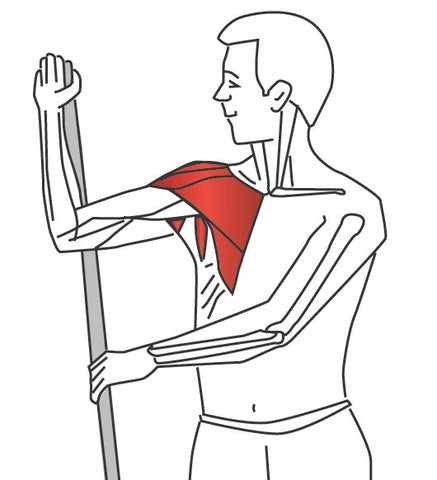Trigger points in the teres major muscle are associated with many common shoulder injuries
The teres major, along with the tendon of the latissimus dorsi, which passes around it, and the subscapularis, forms the posterior fold of the axilla.
Teres major and trigger points
Trigger points in the teres major are typically associated with frozen shoulder syndrome; pain on reaching above head; pain when driving; and common impingement syndromes.
Common causes that lead to the formation of trigger points in teres major include sports related injuries especially forceful overhead lifting, post shoulder fracture/ dislocation, frozen shoulder syndrome, sudden unexpected loading of shoulder (e.g. fall), and prolonged immobility (sling).
Self help tips
Stretching and self-massage can help with pain relief, and sometimes also help dissipate the trigger points. Below are the details of two simple exercises that we often recommend.
Note: This information is intended to be used for information purposes only and is not intended to be used for medical diagnosis or treatment or to substitute for a medical diagnosis and/or treatment rendered or prescribed by a physician or competent healthcare professional. You perform the exercise above at your own risk. Always use your best common sense, and if in doubt about anything, ask a professional!

Technique
Stand with your arm out and your forearm pointing upwards at 90 degrees. Place a broomstick in your hand and behind your elbow. With your other hand pull the bottom of the broomstick forward.
Note
Many people are very tight in the rotator cuff muscles of the shoulder. Perform this stretch very slowly to start with and use extreme caution at all times.

Technique
1. Take a tennis ball or hard rubber ball. There are also some pressure tools that are specifically designed for this task. They are better, but not essential.
2. Place the host muscle in a comfortable position, where it is relaxed and can undergo full stretch.
3. Apply gentle and gradually increasing pressure to the tender point until you feel resistance. This should be experienced as discomfort and not as severe pain.
4. Apply sustained pressure until you feel the tender point yield and soften. This can take from a few seconds to several minutes.
5. Steps 3-4 can be repeated, gradually increasing the pressure on the tender/trigger point until it has fully yielded.
6. To achieve a better result, you can try to change the direction of pressure during these repetitions.
3. Apply gentle and gradually increasing pressure to the tender point until you feel resistance. This should be experienced as discomfort and not as severe pain.
4. Apply sustained pressure until you feel the tender point yield and soften. This can take from a few seconds to several minutes.
5. Steps 3-4 can be repeated, gradually increasing the pressure on the tender/trigger point until it has fully yielded.
6. To achieve a better result, you can try to change the direction of pressure during these repetitions.
Trigger Point Therapy Certification Course - Home Study
Комментариев нет:
Отправить комментарий